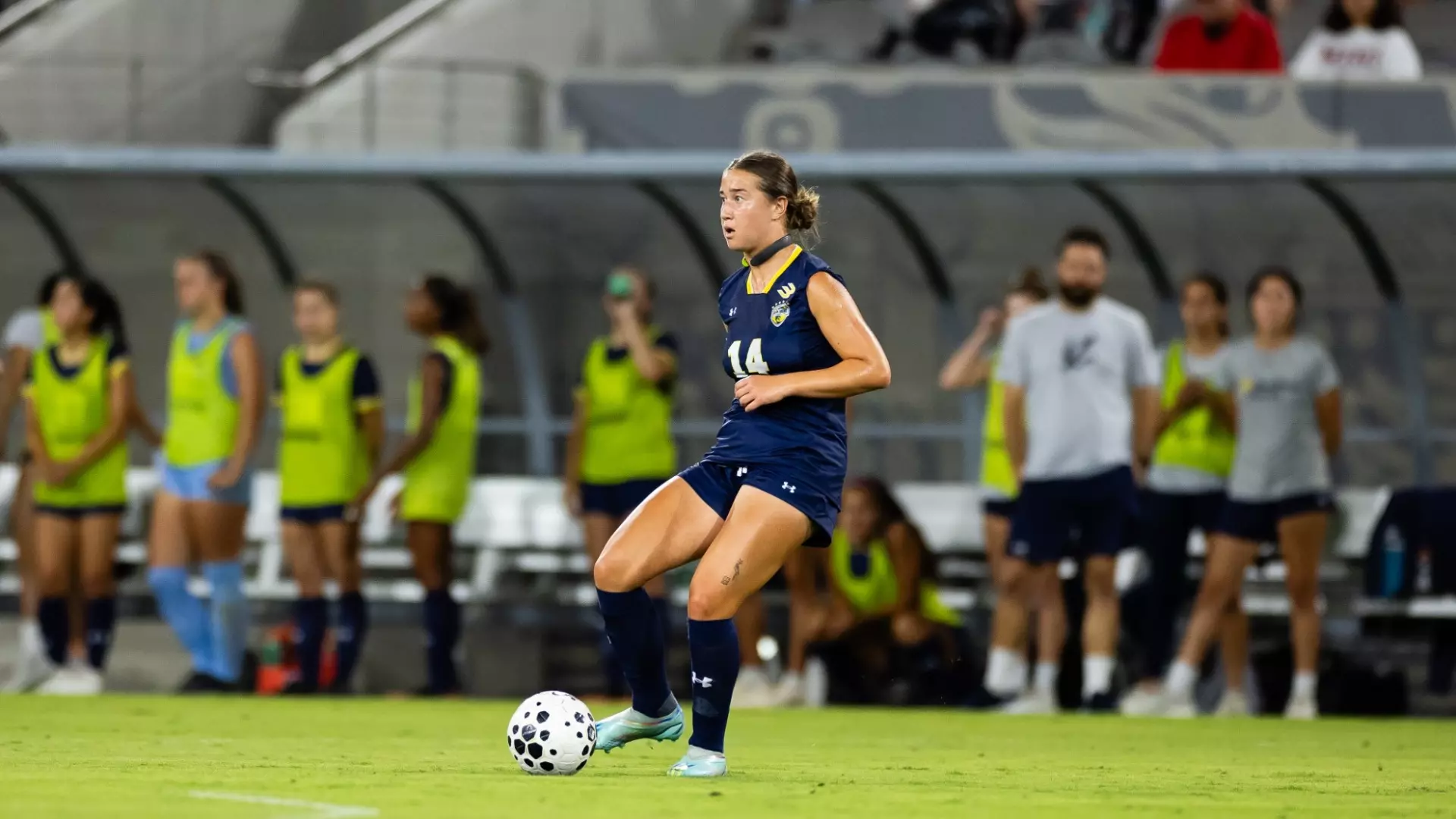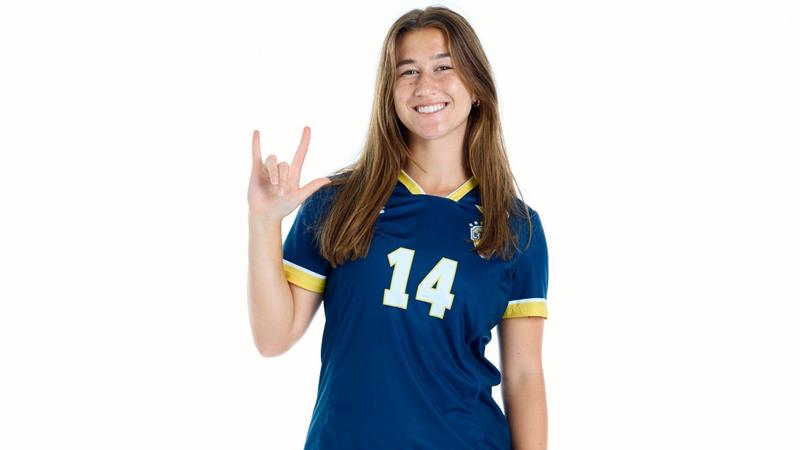Story Links
LA JOLLA, Calif. – “It did feel like something was missing.”
Two years into her time at UC San Diego, Talisa Lin was perplexed. Not in the ‘all-day, every day’ way, but rather in the periodic sense that she lost something along the way. The confusion, seemingly ordinary for a college student, had an equally-as-typical solution: joining a student organization.
As it turned out, however, she wasn’t looking for career opportunities or academic success — she already had the latter down to a science. Instead, she was looking for her roots. Lin found that in the ASL (American Sign Language) Club, and with it, a guiding light centering and recentering her life on and off the pitch.
As a Child of a Deaf Adult (her mother), or CODA, Lin grew up learning ASL as her first language. She knew 50 signs by the time she turned one and picked up the Deaf community culture just as quick. Today, Lin speaks fondly of the demographic’s many intricacies, such as “DST,” Deaf Standard Time.
“It ended at 8 or something, and I think we were there until 8:45 [or] 9 because [my mom] just wanted to meet everyone,” Lin said. “There’s dozens of people outside…signing, and it’s just so lively.”
Being a CODA posed little problem for Lin. In fact, the only deafness-related hindrance came from the ignorance of those supposedly more fortunate. Luckily, Lin built up a strong conviction and pride for her CODA identity through the barrage of nonsensical questions and overly-sympathetic comments.
“When people find out, they’re like, ‘I’m so sorry,’ and that one irks me,” Lin said. “I hate when people apologize because I’m like, ‘Do you even know what you’re apologizing for?’ No, because you view it as something that’s bad and needs to be fixed when it’s not that way at all.”
This misguided energy has developed a dual thick and empathetic skin within Lin, who was quick to reconsider the individuals as possibly just “genuinely curious.” The duality also emboldens a strong appreciation for those who make productive effort:
“It means a lot to me when people in my life are willing to make that effort to learn ASL, even if it’s like a ‘Hi, how are you?’ to talk to my mom,” Lin said. “It really means so much. I can’t even explain it.”
When it came down to it, being a CODA did not prevent Lin from going through the many milestones of life, including going through the all-too-familiar conversation of picking between two sports. A Golden, Colorado native, Lin chose soccer over ski racing due to logistics more than natural talent. Indeed, as farfetched as it may seem now, early signs did not point to footballing greatness for a then four-year-old Lin.
Talisa, age four, on
the pitch
“I would literally pick dandelions and grass, and they would be yelling, ‘Go get the ball, go get the ball, what are you doing?!'” Lin said. “And I would be like, ‘Oh my god, this sucks.'”
Things would begin to come together when she made the switch to competitive soccer in eighth grade. The leap would be one of staunch faith when Lin joined the Colorado Rush, one of the “three R’s” alongside the likes of MLS side Colorado Rapids’ development teams.
Lin capitalized on the tough shift, sharpening her skills against the state’s best in what became a “steady trajectory up.” She dialed up the intensity even more during the pandemic, where she became the team’s go-to center back after a roster overhaul. The exponential growth that followed propelled her into the collegiate spotlight, bright enough to catch the attention of UC San Diego women’s soccer head coach Kristin Jones.
The recruiting process was as swift as the rapid development. Lin committed just weeks after her unofficial visit, and has not looked back since. Her 10-minute debut during the first game of her freshman season made an impression strong enough to make Lin an unquestioned starter for every single game since.
Off the pitch, Lin excels in the classroom as an Anthropology major, specializing in Climate Change & Human Solutions. She has made several All-Academic teams, and even made the Big West Commissioner’s Honor Roll last season. The success, on paper, was rewarding. Yet, in tandem with the physical distance from her family in Colorado, the commitment meant spending less time signing. The regular FaceTime chats with her mom were simply not enough.
Thus, on a whim, Lin attended an ASL Club meeting. Almost immediately, a question arose: “Why haven’t I been doing this the entire time?”
Signing with fellow CODAs and ASL students, as well as Deaf peers and professors, distinctly recentered Lin, who added an ASL minor soon after joining the club. Two years later, she now serves as co-president for the rapidly-growing organization; the group’s poetry night doubled the organization’s attendance goal. Even her post-graduate plans are grounded in moving back to Colorado and attaining her ASL interpreter certification.
As for the soccer pitch, Lin leaves with her head held high. Despite the “so many things breaking in [her] body” that require daily pre-training treatments, Lin continues to anchor, and now captains, a developing Triton squad in her final season. While she doesn’t know what she will do next, Lin has entertained the idea of coaching youth soccer.
“I think it would be fun to coach some 12-year olds or something,” Lin said. “Make them run. Kick a ball around.”
When her time as a Triton does run out, Talisa Lin’s future will undoubtedly be filled with ambiguity. And yet, there will be signs to lead her along.
There always have been. There always will be.

Lin in action at Snapdragon Stadium in San Diego. Photo: Derrick Tuskan/UC San Diego
About UC San Diego Athletics
After two decades as one of the most successful programs in NCAA Division II, the UC San Diego intercollegiate athletics program has begun a new era as a member of The Big West in NCAA Division I. The 24-sport Tritons earned 30 team and nearly 150 individual national championships during its time in Divisions II and III and helped guide 1,400 scholar-athletes to All-America honors. A total of 84 Tritons have earned Academic All-America honors, while 38 have garnered prestigious NCAA Post Graduate Scholarships. UC San Diego scholar-athletes exemplify the academic ideals of one of the world’s preeminent institutions, graduating at an average rate of 90 percent, the highest rate among public institutions in NCAA Division I or II. For more information on the Tritons, visit UCSDtritons.com or follow UC San Diego Athletics on social media @UCSDtritons.

